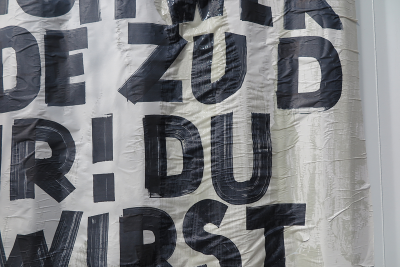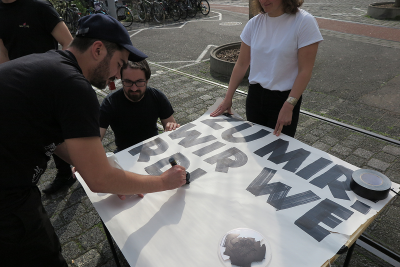Parade or Dazibao?
workshop
Parade or Dazibao?
Today, it is easy to publish: facebook, instagram, twitter for our daily announcements and reaching-out, tinder for our love life, telegram for our secret life, lnkdin for our working life, and many, many other apps lined up to connect for anything we might want or want others to know.
But what is the consequence of this ease, that commodity that has made us into commodities ourselves? What are its implications, physically, psychologically, for our experience of encountering, what its consequences for public making and making public? Looking at formats of making public, this 1-day workshop discusses, plays, and practices embodying as a carrier or a container, taking into account what we decide to render readable, and what should be disguised or remain hidden. Container, body and public space are base, ground and stage.
On the invitation of Thomas Spallek, for ceremonynow

PARADE OR DAZIBAO?
workshop
Tanzhaus NRW
13-29 april 2018
Parade or Dazibao?Today, it is easy to publish: facebook, instagram, twitter for our daily announcements and reaching-out, tinder for our love life, telegram for our secret life, lnkdin for our working life, and many, many other apps lined up to connect for anything we might want or want others to know.
But what is the consequence of this ease, that commodity that has made us into commodities ourselves? What are its implications, physically, psychologically, for our experience of encountering, what its consequences for public making and making public? Looking at formats of making public, this 1-day workshop discusses, plays, and practices embodying as a carrier or a container, taking into account what we decide to render readable, and what should be disguised or remain hidden. Container, body and public space are base, ground and stage.
On the invitation of Thomas Spallek, for ceremonynow
* dazibao are handwritten, wall-mounted posters as a means of protest, propaganda, and popular communication, limited-circulation newspapers, excerpted press articles, and pamphlets intended for public display. used in China since imperial times, becoming more common after the Revolution. A parade is display (someone or something), an assemble for a formal inspection or ceremonial occasion, a public procession, especially one celebrating a special day or event.





